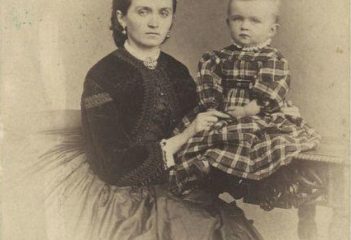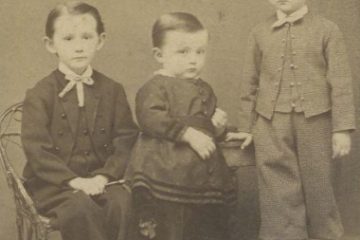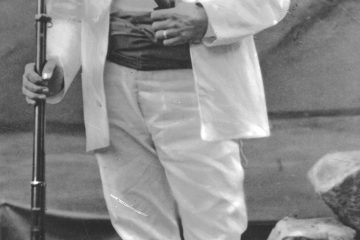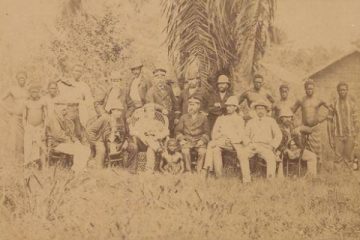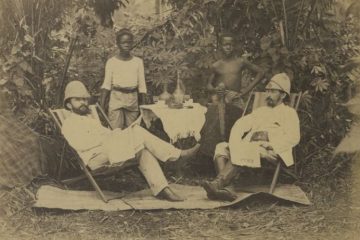Karol Stefan Szolc-Rogoziński - traveller, discoverer, explorer of Cameroon
Author: Mariusz Ryńca
He was born on 14 April 1861 in Kalisz, as the eldest of four sons of the German Evangelist Ludwik Scholtz (1832-1894), a wealthy textile manufacturer, and Malwina, née Rogozińska (1840-1877), daughter of a Warsaw lawyer. Two of his brothers, Emil and Teodor, committed suicide. He was left with Kazimierz, the youngest brother. The family became partly Polonised under the influence of his mother. Although German was the language of communication in the family home, he corresponded with his brother Kazimierz, who was a doctor, in Polish. When Stefan became adult, he Polonized his surname to Szolc, and around 1881 he added to it, as the second part, his mother’s maiden name – Rogoziński. Since then, he signed all his works as S.S. Rogoziński.
Youthful years
Young Stefan was taught by tutors at his family home in Kalisz. When he was twelve, in 1863, he began his education outside the Russian partition, in a German gymnasium in Wrocław. There he made friends with Klemens Tomczek. Even then, dreaming of distant expeditions, he became acquainted with travel and geography literature. Against his father’s wishes, in 1878 he enrolled in the Russian Naval School in Kronstadt. He was an outstanding student and graduated it ahead of schedule in the spring of 1880. The same year, as the youngest officer (midshipman/мичман), he participated in the voyage of the Russian military flotilla on the sailing frigate “General Admiral” from Kronstadt to Vladivostok, around Africa. It was then that he set foot on the African continent for the first time. He saw Algiers and Morocco. Following that experience, he developed his interest in the virtually unknown regions of Equatorial Africa. When on another military voyage he arrived in Paris, in May 1881, he was admitted to the Paris Geographical Society (Société de Géographie de Paris). One month later, at the African Club in Naples, for the first time he publicly presented the idea of an expedition to Equatorial Africa. Moreover, he presented the above idea to the Russian Geographical Society (Императорское Русское Географическое Общество) in St Petersburg, whose member he also was (however, after the expedition had commenced, he was expelled). Despite a favourable reception, he received no adequate financial support. In the autumn of 1881, he left the Russian navy and returned home.
Fighting for dreams
Stefan Rogoziński, with the support of the Polish press, organised a public fundraising campaign for the planned expedition. He emphasised that it was the first Polish expedition to that region of the world, which was intended to attract the attention of Poles who were then deprived of their own country (he also began to use the surname Rogoziński). The idea was enthusiastically accepted by, among others, Wacław Nałkowski, Bolesław Prus, Henryk Sienkiewicz and Filip Sulimierski – the editor and publisher of “Wędrowiec”. However, there were also critical voices. Aleksander Świętochowski, the editor of “Pravda”, openly declared that it was a waste of money. Rogoziński’s father also refused to help him financially. Therefore, he allocated a part of his mother’s inheritance to the expedition. Benedykt Tyszkiewicz also donated substantial amounts of money to the expedition.
On 7 March 1882, Stefan Rogoziński went to France to organise the expedition there. He purchased a small lugger, which he named “Łucja Małgorzata”. Apart from the French flag, it carried the Polish flag with Warsaw’s coat of arms, the Siren. Since he wanted the crew to be composed of Poles, he invited the geologist Klemens Tomczek, whom he had met in Wrocław, as well as the meteorologist Leopold Janikowski, Władysław Ostaszewski and Józef Hirschenfeld-Mielecki to join the expedition. He appointed himself the leader of the Polish expedition to Central Africa. On 13 December 1882, they set sail from the harbour of Le Havre. In Madeira, they were hosted by their sponsor B. Tyszkiewicz, who financed the repair of the ship that had been damaged during a storm. After over four months, on 16 April 1883, they reached the island of Fernando Po (present Bioko in Equatorial Guinea). At that time, Ostaszewski and Hirszenfeld-Mielecki withdrew from the expedition. On 23 April 1883, a week after their arrival, Rogoziński purchased part of Mondoleh Island, in the Ambas Bay off the coast of Cameroon, from a local chief. According to his own notes it cost him: 10 pieces of cloth, 6 rifles (flintlock guns), 3 crates of gin, 4 coffers, 1 black jacket, 1 cylinder, 3 hats, a dozen red caps, 4 dozen jars of pomade, a dozen bracelets and 4 silk handkerchiefs. On 29 April, he arrived in the island and set up a scientific station there, a base for further expeditions. He called it “Stefania”, and the boat used for land expeditions “Warszawianka”.
Expeditions
On 21 July 1883, Rogoziński set out on the first and longest expedition with Tomczek. Their goal was to reach the Liba lakes. They discovered the Balombi-ba-Kotta Lake and several waterfalls on the Peteh and Mungo rivers, near the Meme River and the Roumpi Mountains. Rogoziński, however, due to his illness, had to return and Tomczek continued the journey alone. He discovered, among other places, the Elephant Lake (Balombi-O-M’Bu), named the Benedict Lake, in the honour of Benedict Tyszkiewicz. Then, on 1 January 1884, they both returned to Mondoleh. Rogoziński set out on his second expedition as early as 27 February from the Ambas Bay. The goal was to explore the coast of Cameroon. In the following months he explored the southern slopes of the Cameroon Massif. On 5 March 1884, he climbed Mongo-ma-Etioneleh (1774 m). Unfortunately, on 20 May 1884, Tomczak, who remained on Mondoleh, died of black fever. Between June to 14 July 1884, Rogoziński and Janikowski explored Gabon and the Remboe River region. Then, on 22 October, Rogoziński went on a month-long expedition to Nigeria, the Gold Coast and Liberia.
On 12 December 1884, together with Janikowski and a German, H. Zöller, he climbed the main peak of Cameroon. After this event, the highest of the three peaks of Fako (Mongo-ma-Lobah, 4070 m) was given the name of Rogoziński (Mons Rogozinski), however it was not adopted. The maps he had drawn during his expeditions he sent to the Royal Geographical Society in London. The maps drafted together with Tomczek marked, among others, the Mungo River for the first time. He also compiled dictionaries of local tribes’ languages.
West Africa was of interest to the colonial powers of England, Germany and France, which resulted in conflicts and diplomatic tensions, so Rogoziński tried to manoeuvre between those states. He purchased more land and with the local tribes of Monkounde-Mbenga, Monkounde-Leluta, Ngemeh and Babindo formed the Bots – a kind of tribal federation – in those territories. He tried to avoid having his territories occupied by the increasingly expansive Germans, thus he accepted with the local chiefs English protectorate. He actively cooperated with the British consul. Being discouraged with Anglo-Saxon Protestant missionary methods, in 1884 he handed over his Cameroon properties to French Catholic missionaries of the Congregation of the Holy Spirit. However, the Catholic mission proved to be unsustainable. Rogoziński’s activities provoked fierce attacks on him, including by Otto Bismarck personally in the Reichstag. The German press accused him of “Polish intrigue” and “anti-German activity”. When, as the result of the international conference in Berlin (1884), England withdrew from Cameroon, Germany took its place. All the previous arrangements of Rogoziński were cancelled, and he personally left Africa in the first months of 1885.
After his return to Europe, Stefan Rogoziński delivered lectures on his Cameroon expedition at the Royal Geographical Society in London (of which he became an Honorary Member), and at the Geographical Society of Le Havre (Société de Géographie Commerciale du Havre). He returned to Poland, where he lived in Kalisz and then in Kraków. He also worked on the materials collected during the expedition. He published articles in foreign and domestic magazines, above all in “Wędrowiec”, also in “Tygodnik Ilustrowany”, “Wszechświat”, “Kłosy”, “Gazeta Polska” and “Kurier Warszawski”. He also published the results of his discoveries in the periodicals of the Kraków Academy of Arts and Sciences, and in books, among others: Wyprawa S.S. Rogozińskiego wzdłuż brzegów zachodniej Afryki na lugrze „Łucya-Małgorzata” 1882-1883 (Warsaw 1886, reprinted Warsaw 2011) and Pod równikiem (Warsaw 1886, reprinted Warsaw 2012).
At the end of 1886, Stefan Rogoziński sailed again to Africa. He purchased a 500-hectare coffee plantation on the island of Fernando Po. The income from the plantation was to cover further research, including into the Bubis tribe. He returned to Poland for a while. On 29 August 1888, at St. Alexander’s Parish in Warsaw, he married Helena Janina, née Boguska (1862-1927), a translator and writer, following which they travelled together to the island. He explored the then unknown central part of Fernando Po and climbed its highest peak, Clarence Peak (now Pico Basilé, 3008 m), with his wife. They also travelled to other African countries. However, the business failure of the plantation (a loss of twenty thousand rubles) caused them to return to the country in 1891. Immediately afterwards, Helena filed for divorce, which she obtained four years later (shortly after, she remarried the architect, Tomasz Pajzderski). She made use of the impressions and observations from their journeys in her writings, in the books Z dalekich lądów. Nowele i opowiadania (Warsaw 1893) and the novel Rosa Nieves (Lublin 1925). She also published in “Wędrowiec”.
In the autumn of 1892, Stefan Rogoziński travelled to Egypt to deliver a lecture. He also tried, unsuccessfully, to interest the English in his new expedition to Cameroon. In the summer of 1893, he returned to Poland and began medical treatment at a sanatorium for the neurologically ill in Kraków, and then continued it in Bonn for three months. He still dreamt of travelling, planning an expedition to India and around the world. He even wanted to settle on the Nile or again on Fernando Po. He died on 1 December 1896 in Paris, where he fell under the wheels of an omnibus. He was buried in the Bagneux cemetery in Paris. However, his tombstone has not survived.
Legacy
Stefan Rogoziński donated his extensive ethnographic, anthropological and natural history collections to the Technical and Industrial Museum in Krakow, the Academy of Learning and Skills, and the Museum of Industry and Agriculture in Warsaw. They became the basis of their African collections. His achievements and output provided the cornerstone of Polish African studies. In 1932, the 50th anniversary of Rogoziński’s expedition to Africa was celebrated. The main ceremonies were held in the City Hall of Warsaw, under the patronage of Józef Piłsudski. The celebrations were organised at a time when Poland was experiencing passionate discussions on the possibilities of acquiring colonies and, consequently, seeking traces of its colonial tradition. The achievements of Rogoziński may have been perfectly used for that purpose. It was then that Janikowski, the last surviving participant of the African expedition, publicly indicated that the real purpose of the expedition was to create an independent Polish colony, which was kept secret from the partitioners. It triggered enormous interest in the person of Rogoziński. During the communist period Bolesław Mrówczyński published adventure-historical novels about Rogoziński’s expedition: W poszukiwaniu tajemniczego Bajongu (Warsaw 1955) as well as Góra Bogów (Warsaw 1957).
After 1989, the interest in Stefan Rogoziński has significantly increased. In 2014, Maciej Klósak, Dariusz Skonieczko, Agata Kosmalska and Julian Kernbach, as part of the expedition “Cameroon 2014”, reached the places related to Rogoziński in Cameroon, Gabon and Equatorial Guinea. In January 2016, upon Klósak’s initiative, the Expédition Africaine Rogoziński “Vivat Polonia 2016” was organised (its members were, apart from him, Skonieczko again, also Władysław Rybiński and Tomasz Grzywaczewski). In the course of three weeks, they visited the places in Cameroon (Limbe, Kumba, Yaoundé and Foumban regions) and Nigeria (Calabar).
In Limbe, Cameroon, a plaque commemorating Rogoziński was unveiled on the palace’s wall of Ekoka Molindo, a great-grandson of King Akema, from whom Rogoziński purchased part of the island of Mondoleh. It was designed by Bogdan Wajberg and funded by descendants of the sponsors of Rogoziński’s expedition, Adam Rybiński and Andrzej de Virion, as well as the State Ethnographic Museum in Warsaw and the City of Kalisz. The comic Stefan Szolc-Rogoziński – rejs ku przygodzie (2017, drawn by Adam Polkowski, script by M. Klósak, A. Polkowski, P. Kaczmarek and D. Skonieczko) and the novel by Klósak and Skonieczko Stefan Szolc-Rogoziński. Zapomniany odkrywca Czarnego Lądu (Katowice 2018) were published. The streets in Gliwice, Kraków, Poznań, Przemyśl, Pruszcz Gdański, Warsaw and Wrocław are named in honour of Rogoziński. In Kalisz, at the Main Square, a bas-relief featuring his image was erected (next to portraits of Adam Asnyk, Maria Dąbrowska and Maria Konopnicka). In 2017, near the Stone Bridge, a bronze cast statue of Szolc Rogoziński, sitting on a stone bench and pointing the way to Cameroon, was erected.
Rogoziński’s memorabilia are currently held in the collections of: the Ethnographic Museum in Kraków (the oldest collection), the District Museum of Kalisz Region in Kalisz, the State Ethnographic Museum in Warsaw as well as the National Museum in Szczecin.
Bibliography (selection)
- M. Borowiak, Słownik biograficzny wielkopolskich emigrantów, podróżników i ludzi morza, Nekla 2014, pp. 198-200 (photo);
- Etnografowie i ludoznawcy polscy. Sylwetki, szkice biograficzne, ed. E. Fryś-Pietraszkowa, A. Kowalska-Lewicka, A. Spiss, vol. 1, Kraków 2002, pp. 259-261 (J. Kamocki, photo);
- L. Janikowski, W dżunglach Afryki. Wspomnienia z polskiej wyprawy afrykańskiej w latach 1882-1890, Warszawa 1936.
- L. Janikowski, Wspomnienia z podróży Szolc –Rogozińsiego do Kamerunu w roku 1884, „Morze”, 1931, vol. 3.
- M. Klósak, O Stefanie Szolc-Rogozińskim z perspektywy ekspedycji do Kamerunu, „Rocznik Kaliski”, vol. 41, 2015, pp. 205-212.
- A. Kurek, Stefan Szolc-Rogoziński, świecki inicjator działalności misyjnej, „Collectanea Theologica”, 1978, no. 1, pp. 165-171.
- Polski słownik biograficzny, vol. 25, Wrocław–Warszawa–Kraków–Gdańsk 1980, pp. 30-31 (D. Wawrzykowska-Wierciochowa), vol. 31, Wrocław – Warszawa – Kraków – Gdańsk – Łódź 1988-1989, pp. 470-473.
- W. Słabczyński, T. Słabczyński, Słownik podróżników polskich, Warszawa 1992, pp. 259-263 (photo).
- H. Szumańska-Grossowa, Podróże Stefana Szolca Rogozińskiego, Warszawa 1967; Wielkopolski słownik biograficzny, Warszawa-Poznań 1981, p. 739.
- Wielka Encyklopedia PWN, vol. 20, Warszawa 2004, p. 171, vol. 23, Warszawa 2004, p. 411.
- Internet sources:
- https://pl.wikipedia.org/wiki/Stefan_Szolc-Rogozi%C5%84ski (accessed: 9.11.2021).
- https://www.archiwum.kalisz.pl/zdjecia/wystawyonline/054/prezentacja-17b.pdf (accessed: 9.11.2021).
- http://docplayer.pl/20207492-Wyprawa-stefana-szolc-rogozinskiego-do-kamerunu-a-polskie-marzenia-o-koloniach.html (accessed: 9.11.2021).
Copyright © Institute De Republica
Map
Miejsce urodzenia i zamieszkania po powrocie z Afryki
Kalisz, Polska
Nauka w gimnazjum
Wrocław, Polska
Nauka w szkole marynarki wojennej, miejsce wyruszenia w rejs dookoła Afryki
Kronsztad, Petersburg, Rosja
Miejsce zakończenia rejsu dookoła Afryki
Władywostok, Rosja
Na trasie rejsu z rosyjską flotyllą wojskową
Algieria
Na trasie rejsu z rosyjską flotyllą wojskową
Maroko
Na trasie rejsu z rosyjską marynarką wojskową, przyjęty do Paryskiego Towarzystwa Geograficznego; miejsce śmierci i pochówku
Paryż, Francja
Na trasie rejsu z rosyjską marynarką wojskową
Neapol, Włochy
Członek Rosyjskiego Towarzystwa Geograficznego
Petersburg, Rosja
Miejsce przygotowań do wyprawy do Afryki Środkowej, 1882
Francja
Początek wyprawy do Afryki, 13.12.1882; miejsca głoszenia wykładów o wyprawach w Towarzystwie Geograficznym
Hawr, Francja
Na trasie wyprawy do Afryki, 1882
Madera, Portugalia
Ta trasie wyprawy do Afryki, 16.04.1883 oraz miejsce zakupu plantacji w 1886
Bioko, Gwinea Równikowa
Zakupiona wyspa, gdzie założył stację naukową i wypadową, kwiecień 1883
Mondoleh, Kamerun
Cel pierwszej wyprawy, 1883
Meme River, Kamerun
Cel pierwszej wyprawy, 1883
Rumpi Hills, Kamerun
Odkryte podczas pierwszej wyprawy, 1883
Lake Barombi Koto, Kamerun
Miejsce odkrycia wodospadów podczas pierwszej wyprawy, 1883
Mungo River, Kamerun
Początek drugiej wyprawy - badanie wybrzeży Kamerunu, 1884
Ambas, Limbé, Kamerun
Południowe stoki masywu badane podczas drugiej wyprawy, 1884
Kamerun Mountains, Kamerun
Miejsce wyprawy z 1884
Gabon
Miejsce wyprawy z 1884
Nigeria
Miejsce wyprawy z 1884
Liberia
Miejsce wyprawy z 1884
Ghana
12.12.1884 zdobycie najwyższego szczytu Kamerunu
Mt Cameroon, Kamerun
Miejsca głoszenia wykładów o wyprawach w Królewskim Towarzystwie Geograficznym
Londyn, Wielka Brytania
Miejsce zamieszkania po powrocie z Afryki, opracowywania zebranych materiałów, leczenie w szpitalu dla nerwowo chorych
Kraków, Polska
Miejsce ślubu, 29.08.1888
Warszawa, Polska
Najwyższy szczyt wyspy Fernando Po (ob. Bioko) zdobyty wraz z żoną
Pico Basilé, Gwinea Równikowa
Miejsce wygłoszenia odczytu w 1892 roku
Egipt
Miejsce pobytu na leczeniu
Bonn, Niemcy


